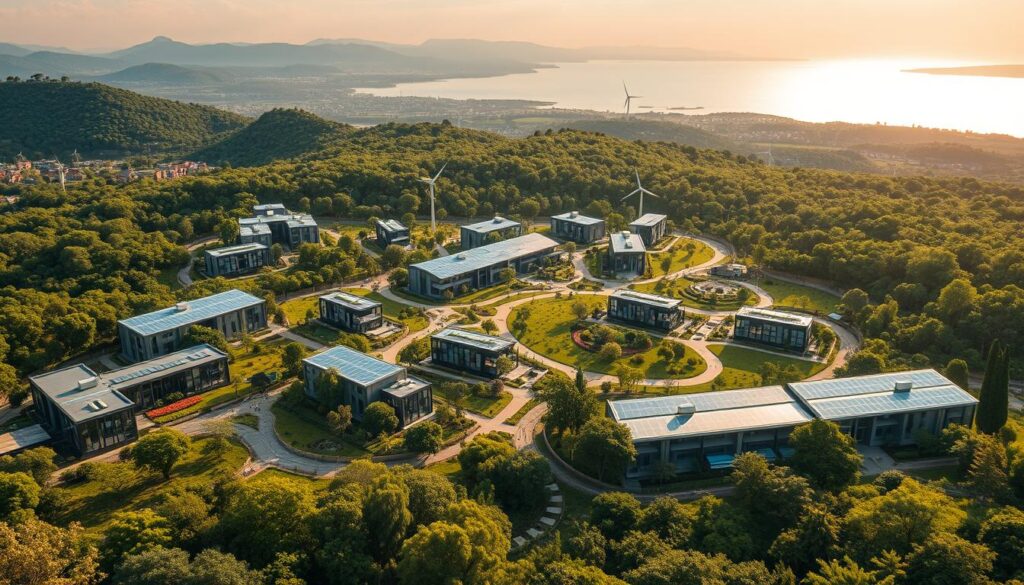As the world grapples with the challenges of climate change, population growth, and environmental degradation, a critical question arises: Can our cities and communities be redesigned to thrive in a rapidly changing world?
The answer lies in eco-friendly development and the adoption of sustainable infrastructure practices that minimize environmental impact while promoting economic growth and social well-being.
By rethinking the design and operation of buildings, transportation systems, and other critical infrastructure, we can create a more resilient and sustainable future.
Key Takeaways
- Eco-friendly development is crucial for minimizing environmental impact.
- Sustainable infrastructure practices promote economic growth and social well-being.
- Rethinking infrastructure design can lead to a more resilient future.
- Adopting sustainable practices is key to shaping a greener tomorrow.
- Sustainable infrastructure is vital for addressing climate change and population growth.
Understanding Sustainable Infrastructure Design
In the quest for a greener tomorrow, understanding sustainable infrastructure design is paramount. Sustainable infrastructure is defined as infrastructure that is designed to be resilient, adaptable, and environmentally friendly.
Definition and Importance
Sustainable infrastructure encompasses a broad range of practices and technologies aimed at reducing environmental impact while supporting economic growth. According to a report on sustainable infrastructure, it’s crucial for meeting the needs of the present without compromising the ability of future generations to meet their own needs.
The importance of sustainable infrastructure cannot be overstated. It plays a critical role in mitigating climate change by reducing greenhouse gas emissions and enhancing energy efficiency.
Key Principles of Sustainability
The key principles of sustainability in infrastructure design include:
- Designing for energy efficiency and renewable energy
- Using sustainable materials and reducing waste
- Incorporating green spaces and urban planning to enhance biodiversity and reduce urban heat island effects
These principles are fundamental to green urban planning and sustainable architecture, ensuring that infrastructure projects are not only environmentally friendly but also resilient and adaptable to future challenges.
Benefits of Sustainable Infrastructure
The benefits of sustainable infrastructure are multifaceted, including reduced operational costs through energy efficiency, enhanced public health through improved air and water quality, and increased property values through aesthetic and functional improvements.
Moreover, sustainable infrastructure can stimulate local economies by creating jobs and attracting investments in green technologies.
The Role of Urban Planning in Sustainability
Urban planning is pivotal in shaping sustainable cities by integrating green spaces and promoting eco-friendly development. As cities continue to grow, the importance of effective urban planning in achieving sustainability cannot be overstated.
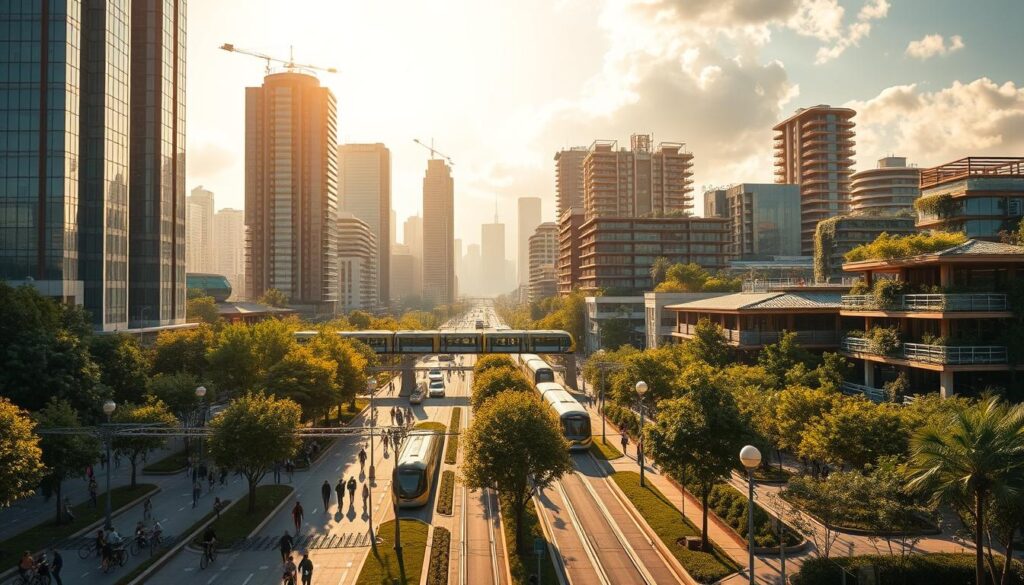
Integrating Green Spaces into Cities
Integrating green spaces into urban landscapes is a critical aspect of sustainable urban planning. Green spaces not only enhance the aesthetic appeal of cities but also play a significant role in reducing urban heat islands, improving air quality, and providing habitats for urban wildlife.
- Urban parks and gardens help in mitigating the effects of climate change.
- Green roofs and walls contribute to energy efficiency and biodiversity.
- Green corridors facilitate the movement of wildlife through urban areas.
By incorporating green infrastructure, cities can become more livable and resilient. For instance, green roofs can reduce stormwater runoff and provide insulation, thereby lowering energy consumption.
Smart Growth Strategies
Smart growth strategies are essential for promoting sustainable construction practices and eco-friendly development. These strategies focus on creating compact, walkable, and mixed-use developments that reduce the need for sprawl.
- Encouraging mixed-use development to reduce commute times.
- Promoting dense, walkable neighborhoods.
- Investing in public transportation to reduce reliance on personal vehicles.
By adopting smart growth strategies, cities can reduce their environmental footprint while enhancing the quality of life for their residents.
Zoning for Sustainability
Zoning regulations play a crucial role in promoting sustainability by dictating how land is used and developed. By incorporating sustainability criteria into zoning laws, cities can encourage eco-friendly development and sustainable construction practices.
Effective zoning for sustainability involves:
- Encouraging the use of renewable energy sources.
- Promoting energy-efficient building practices.
- Protecting natural habitats and green spaces.
By zoning for sustainability, cities can ensure that development is aligned with environmental goals, leading to a more sustainable future.
Sustainable Materials in Construction
The construction industry is shifting towards sustainable materials, driven by the need for environmentally conscious engineering. This shift is crucial for reducing the environmental footprint of construction projects and promoting sustainable landscape design.
Sustainable materials are critical in construction, offering numerous benefits, including reduced energy consumption, lower greenhouse gas emissions, and minimized waste. These materials can be locally sourced, recycled, or sustainably harvested, providing a range of options for builders and architects.
Eco-Friendly Material Options
The types of eco-friendly materials available for construction are diverse. Some examples include:
- Recycled materials, such as reclaimed wood and recycled metal
- Sustainably sourced materials, like bamboo and FSC-certified timber
- Low-carbon materials, including low-carbon concrete and insulation made from recycled materials
For more information on sustainable building materials, visit World Civil Society.
Recycled vs. Renewable Resources
Understanding the difference between recycled and renewable resources is essential for making informed decisions in construction. Recycled materials are reprocessed from post-consumer or post-industrial waste, reducing the need for virgin materials. Renewable resources, on the other hand, are replenished naturally over time and can be harvested sustainably.
Both types of resources have their benefits and should be considered in sustainable landscape design and construction projects.
Life Cycle Assessment of Materials
Conducting a life cycle assessment (LCA) of materials is a critical step in evaluating their environmental impact. LCA considers the extraction, processing, transportation, installation, maintenance, and eventual disposal of materials, providing a comprehensive understanding of their environmental footprint.
By choosing materials with a lower environmental impact, as identified through LCA, builders and architects can significantly reduce the overall sustainability footprint of their projects.
Energy Efficiency in Infrastructure
Energy efficiency is a cornerstone of sustainable infrastructure, driving innovations that reduce consumption and emissions. As we move towards a greener future, it’s essential to understand the role of energy efficiency in shaping our infrastructure.
Innovations in Energy-Efficient Design
The design phase is critical in determining the energy efficiency of infrastructure projects. Innovative designs that incorporate energy-efficient technologies can significantly reduce energy consumption. For instance, buildings can be designed with natural ventilation systems and daylight harvesting techniques to minimize the need for artificial lighting and heating or cooling systems.
According to recent studies, incorporating energy-efficient design principles can lead to substantial energy savings. For example, a study by the Harbingerland Blog highlights the importance of sustainable design in reducing energy consumption.
Renewable Energy Integration
Integrating renewable energy sources into infrastructure is another crucial aspect of energy efficiency. Renewable energy can be harnessed through solar panels, wind turbines, and other technologies to power buildings and cities. This not only reduces reliance on fossil fuels but also decreases greenhouse gas emissions.
| Renewable Energy Source | Benefits | Applications |
|---|---|---|
| Solar Energy | Abundant resource, zero emissions | Powering buildings, streetlights |
| Wind Energy | Low operational costs, scalable | Powering cities, industrial sites |
Smart Grids and Their Advantages
Smart grids are advanced energy management systems that optimize energy distribution and consumption. By leveraging real-time data and analytics, smart grids can predict energy demand, detect outages, and manage energy storage more efficiently. This leads to reduced energy waste and improved reliability.
As discussed in the article on World Civil Society, smart grids are a key component in the future of sustainable infrastructure, enabling greater integration of renewable energy sources and enhancing energy security.
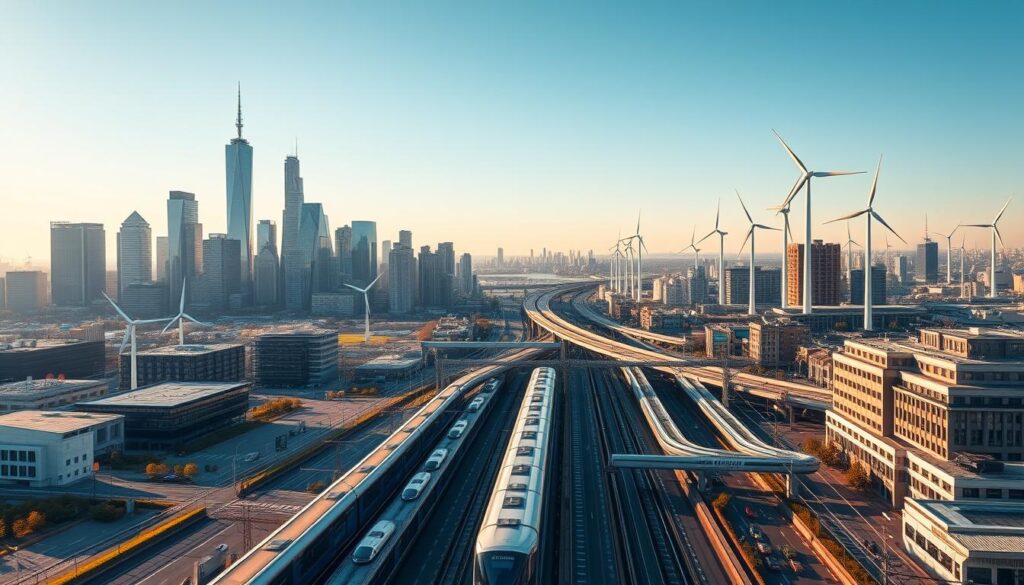
Water Management and Conservation
Water management and conservation are key components of sustainable construction practices, playing a vital role in reducing waste and promoting eco-friendly development. Effective water management strategies are crucial for minimizing the environmental impact of infrastructure projects.
There are several techniques used in water conservation, each offering unique benefits. One such method is rainwater harvesting, which involves collecting and storing rainwater for various uses.
Rainwater Harvesting Techniques
Rainwater harvesting systems can be implemented in various settings, from residential buildings to large-scale industrial projects. These systems not only reduce the demand on groundwater but also decrease stormwater runoff, mitigating the risk of urban flooding.
The implementation of rainwater harvesting involves several steps, including the collection of rainwater from rooftops or other surfaces, storage in tanks, and treatment or filtration for use. This technique is particularly beneficial in areas with significant rainfall, providing a supplementary water source.
Greywater Recycling Systems
Another effective water conservation strategy is greywater recycling. Greywater refers to wastewater generated from sinks, showers, and washing machines, which can be treated and reused for irrigation, toilet flushing, and other non-potable purposes.
Greywater recycling systems involve the collection, treatment, and reuse of greywater. These systems can significantly reduce the demand on potable water supplies, lowering water bills and decreasing the environmental impact of wastewater disposal.
Sustainable Drainage Solutions
Sustainable drainage solutions are designed to manage stormwater runoff in a way that mimics natural processes. These solutions include permeable pavements, green roofs, and constructed wetlands, all of which help to reduce urban flooding and improve water quality.
By incorporating sustainable drainage solutions into infrastructure projects, developers can minimize the environmental impact of urbanization. These solutions not only reduce stormwater runoff but also provide habitats for wildlife and improve the aesthetic appeal of urban areas.
In conclusion, water management and conservation are essential for eco-friendly development. By implementing rainwater harvesting techniques, greywater recycling systems, and sustainable drainage solutions, we can significantly reduce the environmental footprint of infrastructure projects, promoting a more sustainable future.
Transportation Planning for the Future
The future of transportation is being shaped by innovations in public transit, walkable communities, and electric vehicle infrastructure. As cities continue to grow and evolve, the need for sustainable transportation planning becomes increasingly important. Effective transportation planning is crucial for reducing congestion, lowering emissions, and enhancing the quality of life for urban residents.
Innovations in Public Transit
Public transit innovations are transforming the way people move around cities. Modern public transit systems are incorporating advanced technologies such as real-time tracking, smart traffic management, and eco-friendly vehicles. For instance, many cities are now adopting electric buses as a cleaner alternative to traditional diesel-powered buses. To learn more about the latest trends in green infrastructure, visit World Civil Society.
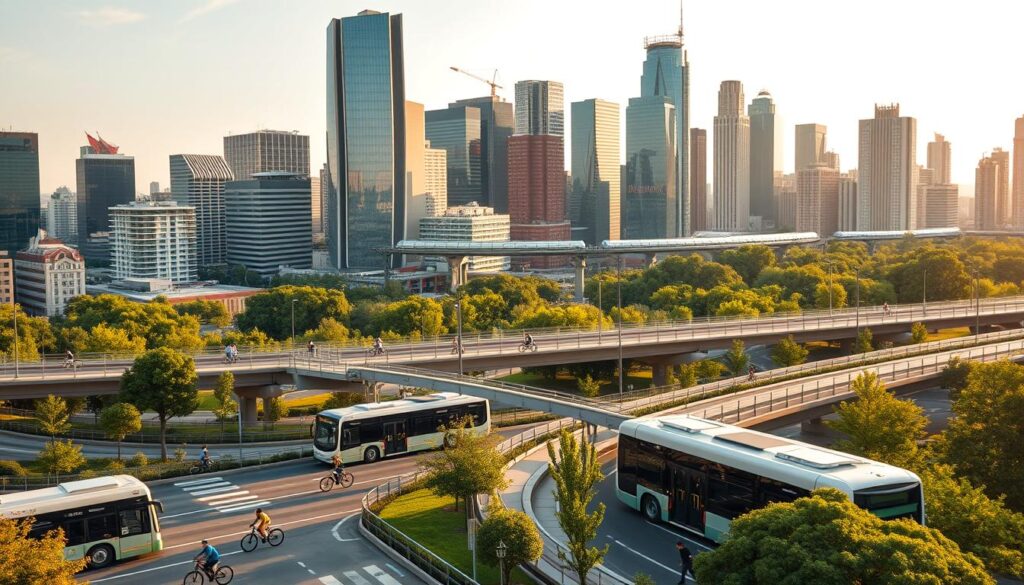
- Integration of public transit with bike-sharing and ride-sharing services
- Implementation of smart traffic signals to prioritize public transit
- Development of dedicated bus lanes to reduce travel times
Promoting Walkable Communities
Creating walkable communities is another critical aspect of sustainable transportation planning. Walkable communities not only promote physical activity and reduce reliance on cars, but they also foster a sense of community and improve local businesses. Key strategies for promoting walkable communities include:
- Designing streets with pedestrian-friendly infrastructure
- Implementing mixed-use development to reduce the need for lengthy commutes
- Enhancing public spaces to make them more inviting
Electric Vehicle Infrastructure
The adoption of electric vehicles (EVs) is on the rise, driven by the need to reduce greenhouse gas emissions and dependence on fossil fuels. Developing comprehensive EV infrastructure is essential to support this trend. This includes:
| EV Infrastructure Component | Description | Benefits |
|---|---|---|
| Public Charging Stations | Strategically located charging points | Convenience for EV owners |
| Fast-Charging Corridors | High-speed charging along highways | Reduced range anxiety |
| Residential Charging Solutions | Home charging units for private residences | Ease of use for homeowners |
By investing in these areas, cities can create a more sustainable, efficient, and livable transportation system for the future.
The Impact of Climate Change on Infrastructure
As climate change continues to escalate, its impact on infrastructure has become a pressing concern. Rising temperatures and more frequent extreme weather events are testing the limits of our infrastructure, from roads and bridges to buildings and public transportation systems.
Resilience in Design
To mitigate the effects of climate change, it’s essential to incorporate resilience in design. This involves designing infrastructure that can withstand and adapt to the changing climate conditions. According to a report by Climate Columbia, investing in climate-resilient infrastructure can have significant economic benefits, including reduced damage from extreme weather events.
Infrastructure designers are now focusing on creating systems that are not only functional but also adaptable to future climate scenarios. This includes using advanced materials and technologies that can withstand extreme temperatures, flooding, and other climate-related stressors.
Adapting to Extreme Weather Events
Extreme weather events, such as hurricanes, floods, and droughts, are becoming more frequent and intense due to climate change. Infrastructure must be designed to adapt to these events, ensuring that communities remain safe and connected. This can involve implementing flood-resistant construction techniques, designing roads that can withstand extreme weather conditions, and creating early warning systems for impending disasters.
Moreover, adapting to extreme weather events requires a comprehensive approach that involves not just infrastructure design but also community preparedness and emergency response planning.
Risk Assessment Strategies
Effective risk assessment strategies are crucial for identifying potential vulnerabilities in infrastructure and developing strategies to mitigate these risks. This involves analyzing data on climate trends, assessing the condition of existing infrastructure, and modeling potential future climate scenarios.
By adopting a proactive approach to risk assessment, infrastructure owners and operators can reduce the likelihood of failures and minimize the impact of extreme weather events on their assets.
Community Involvement in Sustainable Projects
Public participation plays a vital role in shaping sustainable infrastructure projects that meet community needs. By engaging local communities, projects can better address the needs and concerns of the people they affect.
Engaging Local Communities
Engaging local communities is a multifaceted process that involves educating the public, soliciting feedback, and incorporating community ideas into project designs. This can be achieved through public meetings, surveys, and collaborative planning sessions.
Effective community engagement not only fosters a sense of ownership among community members but also ensures that projects are tailored to meet local needs.
“Community engagement is not just about informing the public; it’s about involving them in the decision-making process.”
Crowdsourcing Ideas for Infrastructure
Crowdsourcing ideas for infrastructure projects can lead to innovative solutions that might not have been considered by planners. By leveraging the collective knowledge of the community, projects can benefit from diverse perspectives.
- Utilizing online platforms for idea submission
- Hosting hackathons or community workshops
- Conducting surveys to gather community input
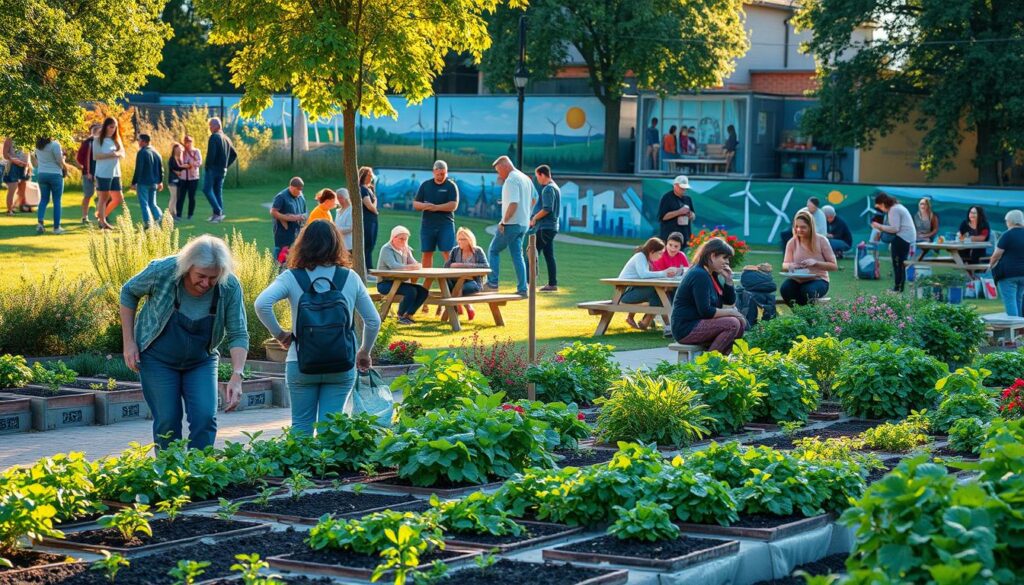
Benefits of Public Participation
Public participation in sustainable projects offers numerous benefits, including enhanced community support, improved project design, and increased transparency.
| Benefits | Description |
|---|---|
| Enhanced Community Support | Increased public acceptance and support for projects |
| Improved Project Design | Better alignment with community needs and preferences |
| Increased Transparency | Clear communication and decision-making processes |
By embracing community involvement, sustainable infrastructure projects can achieve greater success and longevity.
Policy and Regulation in Sustainable Design
The role of policy and regulation in shaping sustainable design practices cannot be overstated. As the world moves towards more eco-friendly development, the importance of a robust regulatory framework becomes increasingly evident. Policy and regulation are not just about compliance; they are about creating an environment that fosters innovation and sustainability in infrastructure design.
Government Incentives for Green Projects
Government incentives play a crucial role in encouraging the adoption of sustainable practices in infrastructure projects. These incentives can come in various forms, such as tax credits, grants, and subsidies for projects that meet specific sustainability criteria. For instance, the U.S. government offers tax incentives for renewable energy projects, which has spurred significant investment in this sector.
Some of the key government incentives include:
- Tax credits for renewable energy installations
- Grants for green infrastructure projects
- Subsidies for energy-efficient buildings
Building Codes and Sustainability Standards
Building codes and sustainability standards are critical in ensuring that infrastructure projects are designed and constructed with sustainability in mind. These codes and standards provide a framework for what constitutes sustainable design and help ensure that projects meet minimum environmental performance criteria.
A notable example is the International Green Construction Code (IgCC), which provides a comprehensive framework for sustainable construction practices. Adopting such codes can significantly enhance the sustainability of infrastructure projects.
| Code/Standard | Description | Benefits |
|---|---|---|
| IgCC | Comprehensive framework for sustainable construction | Enhanced sustainability, reduced environmental impact |
| LEED | Leadership in Energy and Environmental Design certification | Recognition for sustainable buildings, energy efficiency |
| ASHRAE 90.1 | Standard for energy efficiency in buildings | Improved energy performance, reduced operational costs |
Environmental Impact Assessments
Environmental Impact Assessments (EIAs) are a crucial tool in the regulatory framework for sustainable infrastructure design. EIAs help identify the potential environmental impacts of a project, allowing for measures to be taken to mitigate adverse effects.
The process involves several key steps, including:
- Screening to determine if an EIA is required
- Scoping to identify the key issues to be addressed
- Assessment and evaluation of potential impacts
- Mitigation measures to reduce adverse effects
In conclusion, policy and regulation are fundamental to promoting sustainable infrastructure design. Through government incentives, building codes, sustainability standards, and environmental impact assessments, we can create a more sustainable future. It is essential for policymakers, developers, and stakeholders to work together to ensure that these regulatory frameworks are effective and supportive of eco-friendly development.
Technological Innovations in Infrastructure
Sustainable infrastructure is being reshaped by technological innovations that enhance efficiency and reduce environmental impact. The integration of advanced technologies is crucial for creating resilient and adaptable infrastructure that can meet the demands of a rapidly changing world.
Smart Infrastructure Technologies
Smart infrastructure technologies involve the use of sensors, IoT devices, and data analytics to create intelligent systems that can monitor and manage infrastructure in real-time. These technologies enable predictive maintenance, reducing the likelihood of failures and improving overall system reliability.
For instance, smart grids can dynamically manage energy distribution, while smart water management systems can detect leaks and optimize water usage. The application of sustainable construction practices in conjunction with smart technologies further enhances the environmental benefits of infrastructure projects.

| Technology | Application | Benefit |
|---|---|---|
| IoT Sensors | Real-time monitoring | Enhanced predictive maintenance |
| Data Analytics | Informed decision-making | Optimized resource allocation |
| Smart Grids | Efficient energy distribution | Reduced energy waste |
IoT in Sustainable Design
The Internet of Things (IoT) plays a vital role in sustainable infrastructure design by enabling the creation of interconnected systems that can optimize performance and reduce waste. IoT devices can monitor environmental conditions, traffic flow, and energy usage, providing valuable data for transportation network engineering and urban planning.
By leveraging IoT technology, cities can implement data-driven solutions that enhance the quality of life for residents while minimizing environmental impact. For example, smart traffic management systems can reduce congestion and lower emissions, contributing to green urban planning initiatives.
Future Trends in Infrastructure Technology
The future of infrastructure technology is expected to be shaped by advancements in areas such as artificial intelligence, blockchain, and 5G connectivity. These technologies will enable the development of more sophisticated smart infrastructure systems, further enhancing the sustainability and resilience of cities.
As technological innovations continue to evolve, it is essential for infrastructure developers to stay abreast of these trends and incorporate them into their projects. By doing so, they can create infrastructure that not only supports current needs but is also adaptable to future challenges.
Economic Considerations of Sustainable Infrastructure
Sustainable infrastructure is not just an environmental imperative but also an economic one, requiring careful consideration of various financial factors. As the world shifts towards more sustainable practices, understanding the economic implications of such infrastructure is crucial.
Cost-Benefit Analysis
A thorough cost-benefit analysis is essential for evaluating the economic viability of sustainable infrastructure projects. This involves assessing both the direct and indirect costs associated with the project, as well as the potential benefits, such as energy savings, reduced maintenance costs, and increased property values.
For instance, a study on the power of economic analysis in revealed that investing in sustainable infrastructure can yield significant long-term economic returns.
Funding Sustainable Infrastructure Projects
Securing funding is a critical step in the development of sustainable infrastructure projects. Various funding strategies can be employed, including public-private partnerships (PPPs), green bonds, and government grants. Public-private partnerships are particularly effective, as they allow for the sharing of risks and rewards between the public and private sectors.
- Government incentives for green projects
- Private investment in sustainable infrastructure
- Green bonds and other financial instruments
Long-Term Economic Benefits
The long-term economic benefits of sustainable infrastructure are multifaceted. Not only do such projects contribute to a reduction in operational costs, but they also enhance the quality of life for communities, potentially leading to increased economic activity and growth.
Moreover, sustainable infrastructure can mitigate the economic impacts of climate change by reducing the risk of damage from extreme weather events and promoting resilience.
In conclusion, the economic considerations of sustainable infrastructure are complex and multifaceted. By conducting thorough cost-benefit analyses, securing appropriate funding, and understanding the long-term economic benefits, stakeholders can make informed decisions that support the development of sustainable infrastructure.
Case Studies of Successful Sustainable Projects
Successful sustainable projects are transforming the way we think about infrastructure, offering valuable lessons for the future. These projects not only contribute to environmental conservation but also provide economic benefits and enhance the quality of life for communities.
Iconic Examples from Around the World
Several iconic sustainable projects worldwide have set new standards for infrastructure development. For instance, the blue-green infrastructure case studies highlight innovative approaches to managing urban water resources and enhancing biodiversity.
One notable example is the Singapore Green Plan, which integrates green spaces into urban planning, promoting sustainable landscape design. This initiative has not only improved the aesthetic appeal of the city but also contributed to a healthier environment.
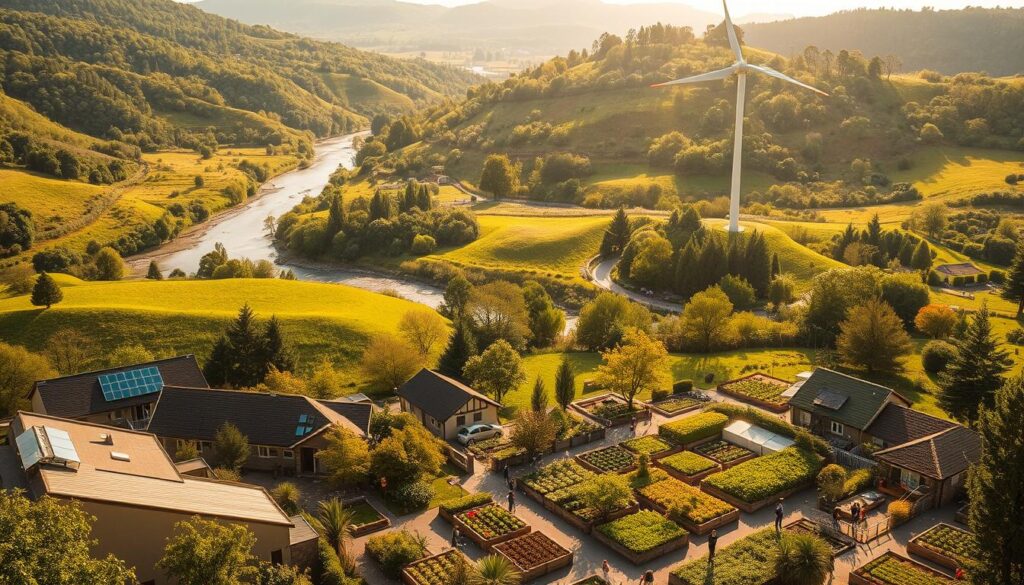
Lessons Learned from Sustainable Initiatives
Analyzing successful sustainable projects reveals key lessons that can be applied to future initiatives. A crucial takeaway is the importance of integrating green infrastructure solutions into urban planning to mitigate the effects of climate change.
For example, companies like those listed among the 20 notable civil engineering companies have pioneered innovative sustainable design practices, showcasing the potential for private sector contributions to sustainable infrastructure.
| Project | Location | Key Features |
|---|---|---|
| Singapore Green Plan | Singapore | Integration of green spaces, sustainable urban planning |
| Copenhagen Climate Adaptation Project | Copenhagen | Cloudburst management, green roofs |
| Vancouver Greenest City Initiative | Vancouver | Renewable energy, green building standards |
Replicating Success in Local Communities
Replicating the success of sustainable projects in local communities requires careful planning and community engagement. It involves understanding the specific needs and challenges of the local environment and tailoring solutions accordingly.
By studying the strategies employed in successful case studies and adapting them to local contexts, communities can develop effective green infrastructure solutions that enhance sustainability and resilience.
Challenges in Implementing Sustainable Design
The path to eco-friendly development is fraught with difficulties. Despite the long-term benefits of sustainable infrastructure, several challenges hinder its widespread adoption.
Common Barriers to Adoption
One of the primary obstacles is the high upfront cost associated with sustainable construction practices. Many stakeholders are deterred by the initial investment, despite the potential for long-term savings.
Another significant barrier is the lack of public awareness and understanding of sustainable design benefits. Education and awareness campaigns are crucial in overcoming this hurdle.
Balancing Costs and Benefits
A detailed cost-benefit analysis is essential for stakeholders to understand the value of sustainable infrastructure projects. This involves not only financial considerations but also environmental and social benefits.
| Cost Component | Traditional Infrastructure | Sustainable Infrastructure |
|---|---|---|
| Initial Investment | $100 million | $120 million |
| Maintenance Costs (10 years) | $50 million | $30 million |
| Energy Costs (10 years) | $80 million | $40 million |
Overcoming Political and Economic Obstacles
Political will and economic incentives play a crucial role in promoting sustainable infrastructure development. Governments can offer tax breaks, grants, and subsidies to encourage private sector participation.
“The future of our planet depends on our ability to adopt sustainable practices. We must work together to overcome the challenges and create a greener tomorrow.”
The Future of Sustainable Infrastructure
As we look ahead, sustainable infrastructure will be defined by cutting-edge technologies and green urban planning. The integration of innovative materials, renewable energy sources, and smart technologies will play a crucial role in shaping the cities of tomorrow.
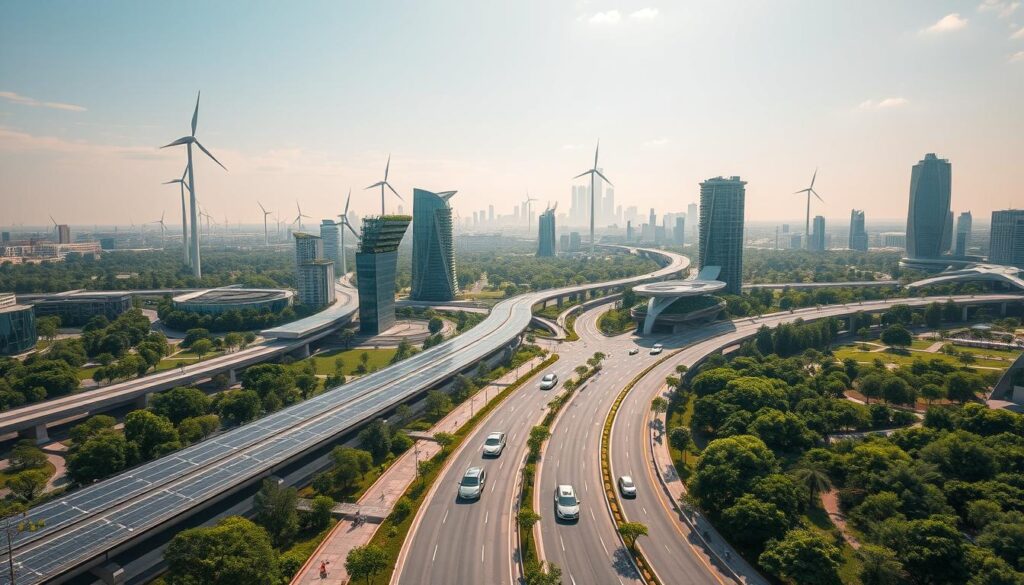
Emerging Trends and Technologies
The future of sustainable infrastructure is being driven by several emerging trends and technologies. One of the key areas is the development of smart infrastructure that can adapt to changing environmental conditions. This includes the use of sensors and IoT devices to monitor and manage infrastructure more efficiently.
Another significant trend is the increasing use of recycled and renewable materials in construction. This not only reduces the environmental impact of infrastructure projects but also helps to conserve natural resources.
Vision for Sustainable Cities
A vision for sustainable cities involves creating urban environments that are not only environmentally friendly but also provide a high quality of life for their inhabitants. This includes designing cities with green spaces, efficient public transportation systems, and buildings that are designed with sustainability in mind.
- Green roofs and walls to reduce urban heat island effects
- Efficient waste management systems
- Promoting walkable and bikeable communities
Global Cooperation for Sustainability
Achieving the goal of sustainable infrastructure on a global scale will require cooperation among governments, private sector entities, and civil society. This includes sharing knowledge, technologies, and best practices to address common challenges.
Global cooperation will also be essential in developing and implementing policies and regulations that support sustainable infrastructure development. By working together, we can create a more sustainable future for all.
Education and Awareness in Sustainability
As we strive for a greener tomorrow, educating the public and professionals alike on sustainable practices is crucial. The journey towards sustainability is complex and multifaceted, requiring a comprehensive approach that includes education, awareness, and community involvement.
Training Professionals in Sustainable Design
Training professionals in sustainable design is a critical component of promoting environmentally conscious engineering and sustainable architecture. This involves equipping architects, engineers, and construction professionals with the knowledge and skills necessary to design and build sustainable infrastructure.
Some key areas of focus for professional training include:
- Understanding sustainable materials and their applications
- Implementing energy-efficient design principles
- Integrating renewable energy systems into building design
- Applying green building techniques and technologies
A study by the U.S. Green Building Council found that buildings that incorporate sustainable design principles can reduce energy consumption by up to 30%. This highlights the importance of educating professionals on sustainable practices.
Public Awareness Campaigns
Public awareness campaigns play a vital role in promoting sustainability by educating the general public about the importance of environmentally friendly practices. These campaigns can take many forms, including social media initiatives, community events, and educational programs.
“Education is the most powerful tool we can use to change the world.” – Nelson Mandela
Effective public awareness campaigns can lead to significant behavioral changes, such as increased recycling, reduced energy consumption, and greater support for sustainable policies.
| Campaign Type | Objective | Potential Impact |
|---|---|---|
| Social Media | Raise awareness about sustainable practices | Millions of people reached, significant behavioral change |
| Community Events | Engage local communities in sustainability initiatives | Increased community involvement, local support for sustainability projects |
The Role of Schools in Promoting Sustainability
Schools play a crucial role in promoting sustainability by educating the next generation about the importance of environmental stewardship and sustainable practices. Incorporating sustainability into school curricula can have a lasting impact on students’ attitudes and behaviors.
Some effective strategies for promoting sustainability in schools include:
- Incorporating environmental education into the curriculum
- Implementing sustainable practices within the school, such as recycling programs
- Encouraging student-led sustainability projects and initiatives
By educating students about sustainability, schools can empower them to become active participants in creating a more sustainable future.
Conclusion: Building a Greener Tomorrow
As we move towards a more sustainable future, it’s clear that sustainable infrastructure is crucial for reducing our environmental footprint. By incorporating green infrastructure solutions and sustainable landscape design, we can create a better tomorrow for generations to come.
Charting the Path Forward
The path forward for infrastructure involves adopting innovative and eco-friendly practices. This includes investing in renewable energy, which is expected to reach USD 1.3 trillion by 2030, and implementing sustainable materials in construction, such as recycled steel and low-carbon concrete, to reduce energy consumption and greenhouse gas emissions.
A Shared Responsibility
Creating a sustainable future is a collective responsibility that requires the active participation of communities, stakeholders, and governments. By working together and leveraging cost-effective solutions like prefabrication and modular construction, we can achieve significant cost savings and reduce environmental impact.
Taking Action
Now is the time to take action. Communities and stakeholders must come together to promote sustainable practices, invest in green infrastructure, and support policies that foster a sustainable future. By doing so, we can build a greener tomorrow that is environmentally conscious, economically viable, and socially equitable.
